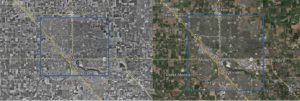
The change in urbanized area from 1998-2015 for Modesto, CA. The city expanded about 0.85% in size annually over the 17 year period from an estimated 47 square miles to 54 square miles.
The population of California is growing and urban development is increasing. According to the latest census, there are about 39.5 million people living within the Golden State. Population is growing around 0.8-0.9% per year, with the anticipation of reaching 40 million Californians by 2018. Migration from other States and Countries, births, and longer life spans are all contributing.
Although a large state in geographical size, this population growth has had a major impact on urbanization. According to the American Farmland Trust organization, there was a 40,000 acre increase in urban development from 2008-2010, with roughly 60% of developed land being considered to be on Prime Farm Ground. Not that much of a surprise considering that the largest cities in California are all on ground that produced high value fruit and vegetable crops (Los Angeles, San Jose, Sacramento, etc).
Sadly, this rate does not appear to be slowing. Every year, roughly 20,000-30,000 acres are paves over. By 2050, it is expected that an additional 2 million acres will be urbanized. To make things worse, California has one of the lowest density within urbanized areas (~9.6 people/acre). This low density urbanization not only impacts sprawl rates, but also increases infrastructure costs, reduces the efficacy of public services, and increases pollution due to decreased walk-ability within the communities.
It is time to make a change in how we develop in California. We need smarter development, more compact development. Cities need to be designed to have more vertical expansion with a focus on redeveloping a city center. This type of living will reduce road congestion, increasing the efficiency of public transportation. Schools and roads will be better funded because the tax base will be larger. Although more expensive to develop, the communities will be stronger and more resilient to population and environmental shifts as the most suitable ground with the lowest risk can be developed. Most of all, the decrease in land lost to urbanization will help preserve the ecological wonders (Yosemite, The Coast, etc) and productivity of the farm ground (producing around 1/8th of the US’s food, 1/3rd of Fruits and Veggies) of California.
Leave a Reply